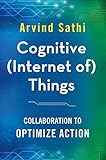Cognitive (Internet of) Things [electronic resource] : Collaboration to Optimize Action / by Arvind Sathi.
By: Sathi, Arvind [author.].
Contributor(s): SpringerLink (Online service).
Material type: BookPublisher: New York : Palgrave Macmillan US : Imprint: Palgrave Macmillan, 2016Description: XVII, 178 p. 17 illus. in color. online resource.Content type: text Media type: computer Carrier type: online resourceISBN: 9781137594662.Subject(s): Computer science | Data structures (Computer science) | Computers | Database management | Data mining | Statistics | Engineering | Computer Science | Information Systems and Communication Service | Data Mining and Knowledge Discovery | Engineering, general | Database Management | Statistics, general | Data Structures, Cryptology and Information TheoryAdditional physical formats: Printed edition:: No titleDDC classification: 005.7 Online resources: Click here to access online
BookPublisher: New York : Palgrave Macmillan US : Imprint: Palgrave Macmillan, 2016Description: XVII, 178 p. 17 illus. in color. online resource.Content type: text Media type: computer Carrier type: online resourceISBN: 9781137594662.Subject(s): Computer science | Data structures (Computer science) | Computers | Database management | Data mining | Statistics | Engineering | Computer Science | Information Systems and Communication Service | Data Mining and Knowledge Discovery | Engineering, general | Database Management | Statistics, general | Data Structures, Cryptology and Information TheoryAdditional physical formats: Printed edition:: No titleDDC classification: 005.7 Online resources: Click here to access online 1. Introduction -- 2. What is a Cognitive Device? -- 3. Cognitive Devices as Human Assistants -- 4. Cognitive Things in an Organization -- 5. Reuse and Monetization -- 6. Intelligent Observations -- 7. Organization of Knowledge and Problem Solving -- 8. Installation, Training, Maintenance, Security, and Infrastructure -- 9. Machine-to-Machine Interfaces -- 10. Man-to-Machine Interfaces -- 11. Assisting in Human Communications -- 12. Balance of Power and Societal Impacts.
This book explores cognitive behavior among Internet of Things. Using a series of current and futuristic examples - appliances, personal assistants, robots, driverless cars, customer care, engineering, monetization, and many more - the book covers use cases, technology and communication aspects of how machines will support individuals and organizations. This book examines the Cognitive Things covering a number of important questions: • What are Cognitive Things? • What applications can be driven from Cognitive Things - today and tomorrow? • How will these Cognitive Things collaborate with each and other, with individuals and with organizations? • What is the cognitive era? How is it different from the automation era? • How will the Cognitive Things support or accelerate human problem solving? • Which technical components make up cognitive behavior? • How does it redistribute the work-load between humans and machines? • What types of data can be collected from them and shared with external organizations? • How do they recognize and authenticate authorized users? How is the data safeguarded from potential theft? Who owns the data and how are the data ownership rights enforced? Overall, Sathi explores ways in which Cognitive Things bring value to individuals as well as organizations and how to integrate the use of the devices into changing organizational structures. Case studies are used throughout to illustrate how innovators are already benefiting from the initial explosion of devices and data. Business executives, operational managers, and IT professionals will understand the fundamental changes required to fully benefit from cognitive technologies and how to utilize them for their own success.


There are no comments for this item.